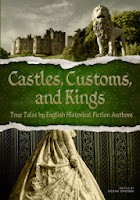I'm totally thrilled to welcome Gabrielle Kimm, author of His Last Duchess and The Courtesan's Lover to tell us about her Next Big Thing - a game I was nominated for by Helen Hollick.
I'm a big fan of Gabrielle's page-turning books, so here are her answers to the next big thing questions.
1) What is the working title of
your next book?
It’s now a fixed and final
title! It’s called ‘The Girl With The Painted Face’.
2) Where did the idea come from
for the book?
My publishers told me that
they were keen for me to write another novel set in Renaissance Italy, as the
two previous books (His Last Duchess
and The Courtesan’s Lover – both set
in that era) have been selling quite nicely so far. As a trained drama teacher, I had been
interested in writing a book about actors for some time, but had presumed that
it would be difficult to come up with a sensible central female character, if
women’s parts in plays at that time were always taken by boys. (Other than the ‘girl pretends to be boy to learn to act and then the truth of her
identity is discovered’ scenario, there didn’t seem to be much opportunity
for an original story. But then in the
course of researching, I came across the biography of an amazing woman called
Isabella Andreini – a consummate Renaissance actress and a writer of some
distinction – and discovered, much to my surprise and delight, that in Europe,
unlike in Puritan Britain, women were as numerous and as successful as men on
the stage. It was an exciting discovery!
The aforesaid Isabella makes a cameo
appearance (as herself!) in my story.
3) What genre does your book fall under?
Historical Fiction.
4) What actors would you choose to play the part of your
characters in a movie rendition?
Oh, this is such a
difficult question! (I’m not that clued up about young actors at the moment
...) There’s a very pretty girl called
Jenna Louise Coleman, who I think would be rather good as my lovely Sofia, and
as for my central male character, Beppe Bianchi ... oh, that’s hard. Beppe’s an actor, a tumbler and a juggler –
he’s quirky and funny and tall and leggy ... the closest I can get is a much
younger David Tennant (Beppe is only twenty-three). But even the adorable Mr Tennant is not quite
right. I’d need to spend time ploughing
through ‘Spotlight’ (directory of actors) to find the right person, I think! There are parts in the story which could
happily be played by Jude Law, Simon Callow, David Suchet and ... oh, possibly Alex
Kingston – but you’ll have to read it to find out which parts!
5) What is the one-sentence synopsis of your book?
Seventeen-year-old
seamstress, Sofia, adopted by an anarchic troupe of travelling actors, is
wrongly accused of murder; a catalogue of misunderstandings and deliberate deceptions
threaten her future happiness.
6) Will your book be self-published or traditionally
published?
Traditionally – like my
other two novels, it will be published by Sphere, an imprint of Little, Brown
(in November 2013).
7) How long did it take you to write the first draft of the
manuscript?
Rather terrifyingly, I was given just over a
year to complete the first draft to a standard fit to be handed in. Each of my previous books having taken the
best part of three years to write, this was something of a challenge! I did manage to make my deadline, but only
just!
8) Who or what inspired you to write this book?
As I’ve said, I was
originally inspired by the discovery of the extraordinary Isabella Andreini
(who amongst her many, many achievements, could improvise in front of a paying
audience ... in rhyming verse!!), but
that then sparked a desire to write about the buzzing and exciting world of
theatre. I’m teaching in a small
performing arts school at the moment, so I regularly spend a couple of days a
week surrounded by ‘the buzzing and exciting world of theatre’ – perhaps it’s
not that surprising that I’ve been wanting to write about it!
9) What else about the book might pique the reader’s
interest?
The story centres around
this troupe of travelling Commedia dell’ Arte actors. The traditions of Commedia dell’Arte are
totally fascinating, and they’re alive and well in the modern world! (I’ve had
the best fun researching - including practical acting workshops with a modern
troupe – the Rude Mechanical Theatre Company - so that I could learn to move
and stand like a real commedia actor.) Although never formally adopted in
Britain, commedia traditions have in
many ways filtered down into our own modern theatrical inheritance, from people
like Charlie Chaplin, through to (surprising though it may seem ...) The
Simpsons! Commedia is a comedy of
archetype – it sets up recognisable pastiches of types of individuals, and then
makes sure that the ‘little man’ wins out over authority and pomposity.
I’m also bringing out a
little ebook ‘prequel’ in October – like an appetite whetter for the main
novel. It will be called ‘Playing a
Dangerous Game’ and will be on Kindle for 99p.
It’s 12,000 words long – so perhaps more of a long short story than
anything else, and it features my central character, Sofia, in a self-contained
story, which leads into the beginning of ‘The Girl with the Painted Face’.
Now, let me introduce you
to a couple of my writer friends. I live and work in rural West
Sussex, and am lucky enough to have two other novelist friends
living nearby. Isabel Ashdown and Jane
Rusbridge and I all met through the MA in Creative Writing course at the
university in Chichester, and we now do lots of author gigs together, both locally
and further afield, under the banner of ‘The Three Sussex Writers’. Jane and Isabel are wonderful writers, and I
feel very fortunate to be able to work with them regularly.
Take a look at their web
sites:
Thanks Gabrielle - all the best with Playing a Dangerous Game and The Girl with the Painted Face.






























